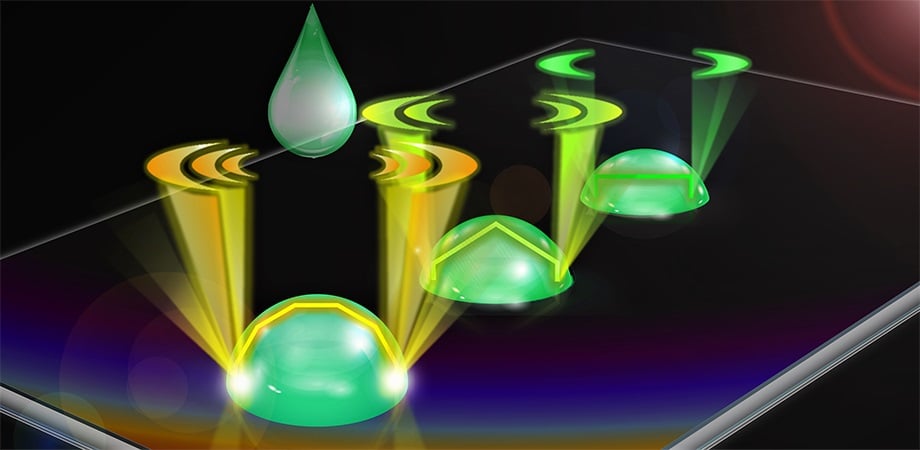SINGAPORE, Feb. 2, 2021 — Researchers from Nanyang Technological University (NTU) found an oscillation mechanism of water droplet resonators, in which the mechanism’s laser resonates along the droplet-air interface in the vertical plane. This discovery could lead to a better understanding of interfacial forces and, specifically, the possibility of using optical resonance to amplify changes to the forces.
Water droplet lasers are used in biological applications, due to water’s ability to confine light with minimal scattering. They also benefit from the laser oscillation that takes place in a microcavity; any subtle change caused by the gain medium or cavity can be amplified. This leads to potentially dramatic changes of laser emission characteristics.
Still, the particularities of optical interaction between droplet resonators and an interface remain largely unknown.

An artistic representation of how a droplet resonator’s geometry is affected by contact angle. Courtesy of Qiao et al.
A team led by Yu-Cheng Chen, professor of electronic engineering at NTU, found that when a droplet interacts with a surface to form a contact angle, the interfacial molecular forces determine a droplet resonator’s geometry. In the new mechanism, according to Chen, a vertically oriented “rainbow-like” or “arc-like” lasing mode reflects back and forth between the two ends of the droplet interface, forming a distinct and very strong laser emission.
Unlike the commonly seen whispering-gallery mode, the team found that its lasing mechanism is much more sensitive to interfacial molecular forces.
“The lasing emissions of this arc-like mode increases dramatically with the increment of interfacial hydrophobicity, as well as droplet contact angle,” Chen said. “Molecular hydrophobicity at the interface can serve as the basis for monitoring subtle biomolecular interactions and dynamics.”
Chen’s team deduced that the quality factor of new lasing modes increased dramatically with an increase to the droplet contact angle. The number of oscillation paths of lasing modes also increased significantly — an important development in explaining the modulating phenomenon.
“Together these two factors determine the enhancement of lasing emissions with the strength of interfacial molecular forces,” Chen said. With that in mind, the team explored the possibility of using droplet lasers to monitor mechanical changes at biointerfaces. As expected, the researchers found that a minute change of interfacial biomolecular forces, induced by a very low concentration of biomolecules such as peptides or proteins, is recordable by the lasing emissions of droplet lasers.
The technology could additionally find use in the study of hydrophobic interactions, which play a role in numerous physical dynamics and biological systems, the researchers said.
The research was published in Advanced Photonics (www.doi.org/10.1117/1.AP.3.1.016003).